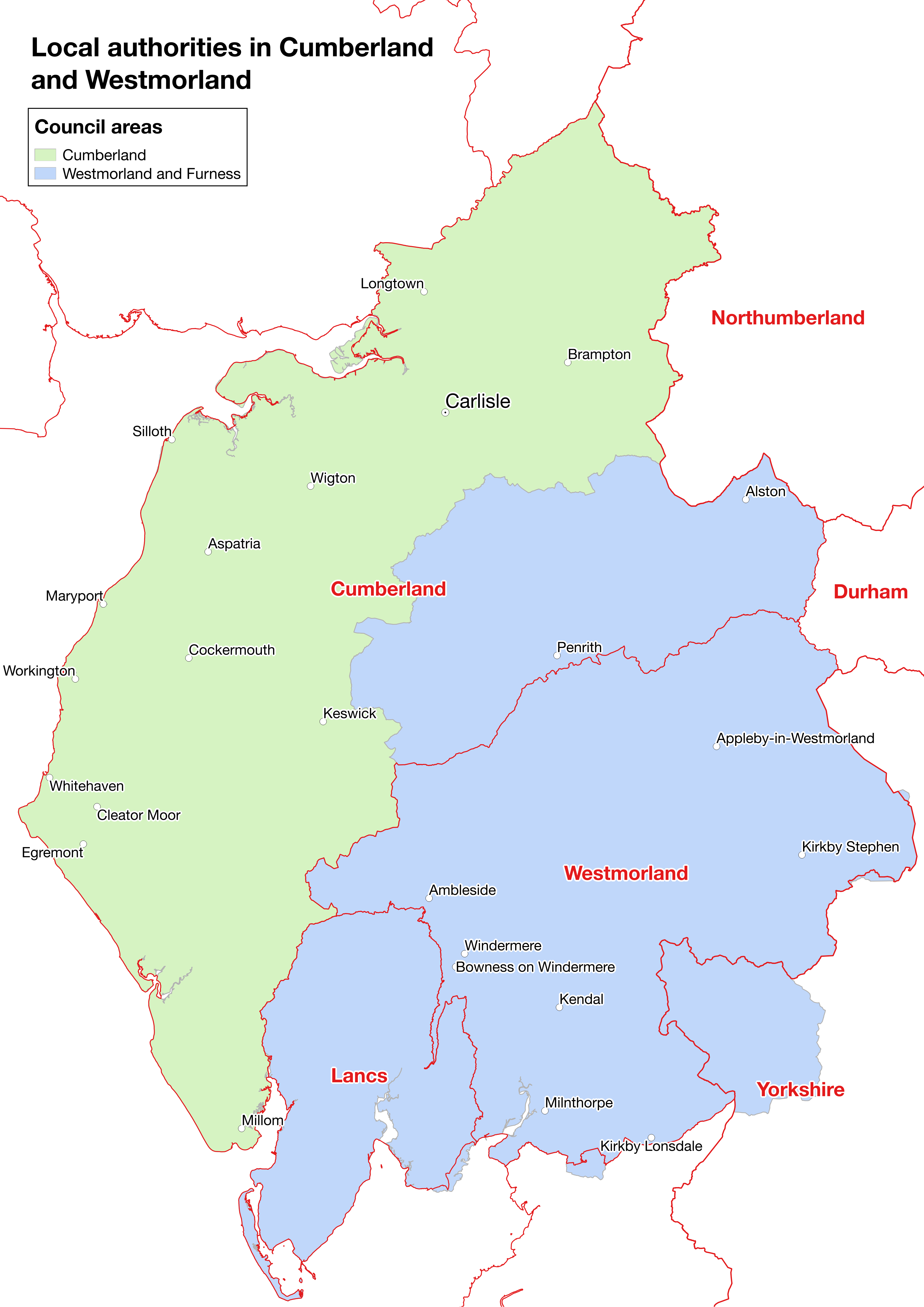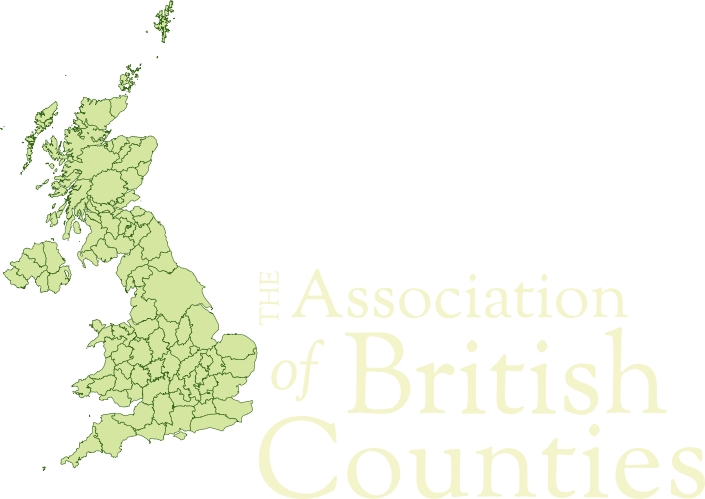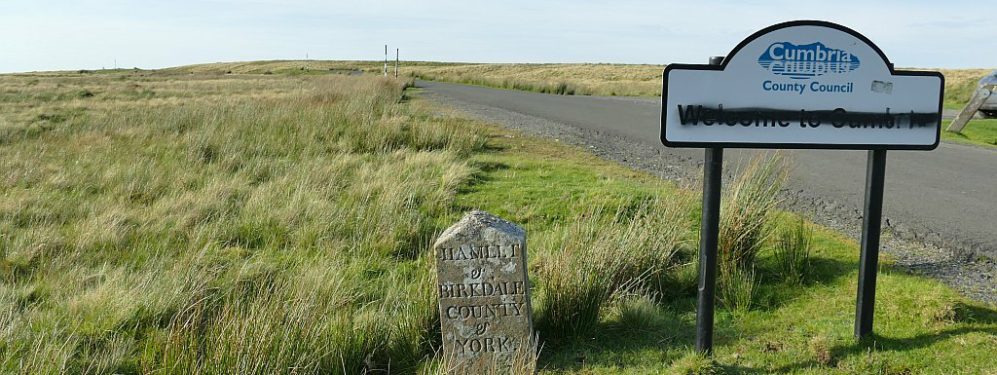The axing of Cumbria County Council has passed its last legal hurdle. The Cumbria (Structural Changes) Order 2022 received Royal Assent on 18th March 2022. On 1st April 2023 Cumbria County Council and the district councils in its area will be abolished and replaced by two new unitary councils:
Cumberland Council – based on the combined area of the current Allerdale, Carlisle and Copeland districts;
Westmorland and Furness Council – based on the combined area of the current Barrow, Eden and South Lakeland districts.

This is a mix of good and bad news from an ABC perspective.
The end of Cumbria County Council is in itself a huge positive. The current Cumbria County Council area covers part of 4 historic counties: all of Cumberland and Westmorland; the Lancashire North of the Sands area of Lancashire; and the Sedbergh area of Yorkshire. The name ‘Cumbria’ is not directly borrowed from an historic county though it is essentially a synonym for Cumberland. Cumbria County Council has consistently fostered the identity of Cumbria as a county, strongly to the detriment of the identities of the historic counties in its area, which it has made no effort to acknowledge or promote. So long. We won’t miss you.
Another positive is that neither of the new councils is to be called ‘county council’ but simply ‘council’. This has been the case with most of the post-1990 unitary authorities created in England and is to be welcomed. An end to a large ‘county council’ and it’s replacement by a number of smaller ‘councils’ can only help make clearer the distinction between local government and the historic counties.
Less positive are the proposed names chosen for the new councils. The area of the new Cumberland Council does at least lie entirely within the real Cumberland and it does contain 90% of the population of the historic county. However, 23% of the historic county, including Penrith and Alston, does not lie in the Cumberland Council area. ‘West Cumberland Council‘ would be more appropriate.
The name Westmorland and Furness Council does have the advantage that it describes the greater part of the council area and is clearly not pretending to be a county or to deny the historic county identity of places within it. The council area includes the whole of ‘Westmorland’ and the whole of the Furness area of Lancashire, as well as the Cartmel peninsula. However, 28% of the council area actually lies in Cumberland and 6% lies in the Sedbergh area of Yorkshire. Finding a name which reflects all of these would be challenging.
Shadow authorities will be elected in May 2022. These will have the right to change the council names used within the legislation.
Unfortunately, rumours of the death of ‘Cumbria’ may have been exaggerated. The so-called “ceremonial county” of ‘Cumbria’ will continue – although a change of lieutenancy areas to match the new council areas would not really be any kind of improvement on the status quo. The continuation of Cumbria Police will also give continued prominence to the name.
Longer term, there is the distinct possibility that a ‘Cumbria’ combined authority will be formed with an elected ‘Mayor of Cumbria’. This is apparently favoured by the Government. There is no intrinsic reason why combined authorities and elected mayors need pose any threat to historic county identities, provided they are not promoted as ‘counties’ and do not misuse county names. Sadly, to call one ‘Cumbria’, given the history of the use of this name, can only continue to undermine the identities of the historic counties of the area.

Lieutenancy areas in the north-west of England compared to the historic counties
What does all this mean for the ‘Cumbria’ brand? A lot will depend on how the media reacts to the local government changes – whether they start to base geographical descriptions on the new local government areas or continue with ‘Cumbria’. As ever with the media, this will all be completely inconsistent and clueless. If the media start to use the new local government areas instead it doesn’t, of course, greatly help ABC’s cause since we believe that the historic counties should be used as the standard geography of the the UK.
We might, however, consider that the end of a corporate body with a vested interest in promoting the notion of the ‘county’ of ‘Cumbria’ can only be a positive thing for the historic counties. The new authorities will, of course, seek to promote their own corporate identities, not brand ‘Cumbria’. We might, though, hope that the successor authorities have more regard to the identities and cultures of the historic counties of their areas: erecting road signs, supporting county days, flying county flags and so on.
Ultimately, all local government change is helpful to ABC since it illustrates the transitory nature of administrative areas and their total unsuitability as a basis for general-purpose geography; for cultural, social and sporting activities; and as a focus of loyalty and identity. All administrative things must pass, but the historic counties endure.


14 thoughts on “Cumbria County Council 1974-2023 R.I.P.”
Very welcome and encouraging news – ‘cumbria’ county council to be abolished.not entirely an emphatic victory for ABC’s total aims,but never the less…
Now to the almost impossible task of abolishing any mention of ‘greater manchester’ – and its self styled despotic ‘leader’ – you know who!!
With the ‘cumbria’ Police and a Mayor in the offing it unfortunately will dig it’s heels in.
The BBC is on steroids with ‘the cause’ going from ” across The COUNTY” & “Here in Cumbria” from 3 times a minute to 4 a minute sometimes being broadcast never mind who is the presenter at any given time.
Also the MSM/local press is craftily insinuating in all it’s journalism/articles that “cumbria” will always be the thing up here…. it by no coincidence states (regardless of the local paper, whichever one it is) that “cumbria County Council” is breaking apart and not the ‘thing’ itself so giving the impression that the new authorities are just bin collections & road repairs coming ‘under’ the ‘king’ they worship called ‘cumbria’.
I for one am sick to death of the name ‘cumbria’. Mkes me laugh when in our local chip shops people ask for a Cumberland sausage but believe me, don’t realise that that name has been around forever and a day.. they do not associate it with any county let alone theirs so ingrained is “cumbria”.
It makes Middlesbrough’s love of the fiction ‘cleveland’ and the vicious hatred of Yorkshire (so weird to hate one’s mother county..) pale into insignificance.
Damned unbelievable considering the abomination was only created on 01/04 1974.
I couldn’t agree with you more.’Cumbria’ and ‘greater Manchester’ are two prime examples that bring on a (metaphorical) vomitting session,every time I hear the wretched names.
People’s ignorance of traditional county names I.e broadcasters,press,politicians and people under say 50 seem to accept (zombie like) post April 1974 ‘new counties’ as ths norm.
Abolishing ‘Cumbria’ county council; is a step in the right direction,but by no means a total victory for ABC’s eventual aims.
P.S. the fight goes on.i’m a proud Lancastrian – by the way.
“A lot will depend on how the media reacts to the local government changes”
Local media include BBC Radio Cumbria and Newsquest, whose local outfit was Cumbrian Newspapers so don’t get your hopes up.
Though better than “cumbria” Westmorland & Furness is not a good name. Given peoples’ propensity to identify with admin areas we’ll soon have people in Barrow (Lancs) or Sedbergh (Yorks) saying they live “in Westmorland.” This will only further muddy the county waters.
I agree with the comments that “cumbria” will cling on due to its ceremonial status. Anyone else see the irony here? For years those of us who wished to see Lancs properly acknowledged were accused of “living in the past”, now our (supremely ignorant) critics will rely for their “identity” solely on the ancient offices of Lords Lieutenant and High Sheriffs!
I predict another confusing dogs breakfast.
My Cumberland and Westmorland Ancestry dates back hundreds of years. I would have liked to seen a three way split based on the traditional counties of Cumberland and Westmorland with a smaller “North Lancashire” county.
My Westmorland side were either “East Ward” around Kirkby Stephen or “West Ward” from Askham.
I came here tonight looking for information on this exact issue. Fortunately you have settled my main question as to the comparison between the council areas and the counties, and the areas of surrounding counties they include.
Apart from its use as an administrative county name (and that of other bodies originally derived therefrom), does the name “Cumbria” have any historic origin, or was it perhaps chosen to sound so?
” the status of north Lancashire, Cumberland and Westmorland (modern cumbria) is uncertain. The area was variously claimed by kings of England, Scotland and Strathclyde. By the second quarter of the 10th century much of the area we know as cumbria was regarded as part of Strathclyde. In 945 Edmund wrested it from Dunmail of Strathclyde and bestowed it on Malcolm of Scotland. Thereafter it seems that the Duddon was regarded as the boundary between the kingdoms. One cannot tell for certain whether Furness and Cartmel had formed part of the lands held by Dunmail but the fact that this area does not seem to have formed part of the grant to Scotland suggests that it had remained in English (or Anglo Scandinavian) hands.”
The Origins of Lancashire. Denise Kenyon. Manchester University Press.
I had the same question as the name ‘cumbria’ gives, prima facie, the impression of ancient origins (I was thinking of Mercia, Wessex, Northumbria, &c.). But no, there was never an ancient ‘Cumbria’ and this name was in fact a fabrication of 1970s origin. No doubt the inventors of the name chose it with the cynical intention of misleading people into the idea of some true historic provenance.
Sadly, plenty of people seem to have been misled 🙁
Cumbria Police dates back to at least August 1967, however – something I found out when searching old newspapers at the British Newspaper Archive. Not sure why the name was chosen for the area or whether the force had jurisdiction over the Furness region of Lancashire in addition to Cumberland and Westmorland from its inception.
I was parked in a layby on the A66 at stainmore near the border sign Cumbria and county Durham and noticed the sign saying border of historical Cumbria and county Durham unbelievable that 1974 is historical no mention of Westmoreland or Cumberland .
And sadly no mention of the North Riding of Yorkshire as that part of Durham’s administrative area is actually Yorkshire.
The County Durham and Darlington unitary authorities are just as stubborn in this regard, Darlington were very quick to remove all County Durham signs crossing the Tees at what is both the historical and ceremonial boundary as Darlington seems to forget its place in the Ceremonial County.
Yet I can go downstream to my hometown of Stockton on Tees and find the historic boundaries marked at three key Tees crossings. Sadly not the A19 flyover, Newport Bridge or Transporter Bridge.
I presume all the major roads leading into Durham County Council’s territory have signs welcoming motorists to “County Durham” at the points where they enter the said territory, but is “Land of the Prince Bishops” on the signs too, despite how different the council area’s boundaries are from the boundaries of the area the prince bishops did once rule?
Also, do the Yorkshire signs at those three key Tees crossings mention the North Riding as well as the county?